
Where exactly am I?
Strictly speaking this is a Brentford walk, not a Hanwell one. For some reason I’ve always thought Hanwell extends down as far as Swyncombe Avenue, or maybe even The Ride. As I got ready to start this second part of my Hanwell stroll down Boston Manor Road, the new infographic just outside Boston Manor station caught my eye. There, at the top, it boldly stated ‘BRENTFORD’. So Boston Manor station isn’t in Hanwell; it’s in the top-left corner of Brentford. I’ve lived just up the road in Hanwell for just shy of 20 years and I didn’t know that.

The new infographic sign.
Well, wherever it is, Boston Manor station sits on top of the bridge where the Boston Manor Road rises to cross the Piccadilly line, then dips again. To the left, or northwest, the road bends on up towards Hanwell Broadway.

Boston Manor Road looking north-west.
About 120 years ago it looked like this – a country lane with grass verges under hedge, fence, trees and fields. Must have been some upheaval when that was all built on in the 1930s.*
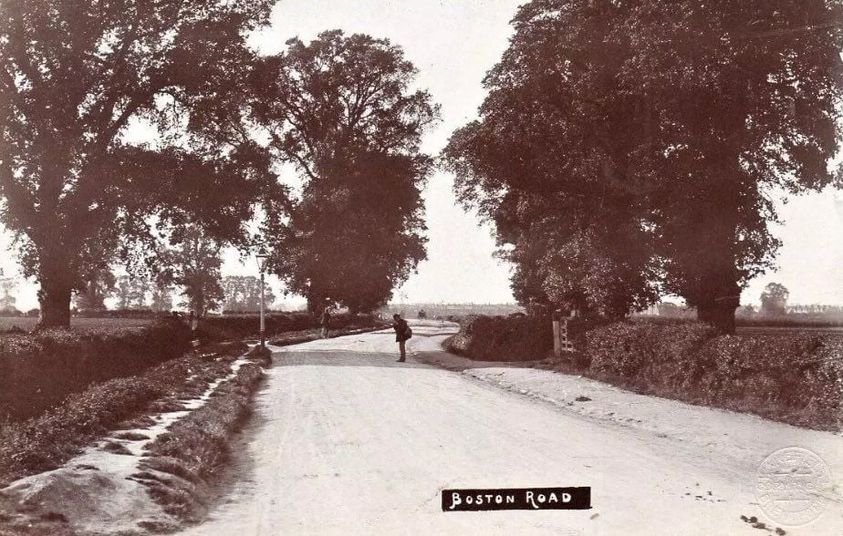
The same view 120 years ago. Not sure what that bloke is up to.
Boston Manor station reminds me a bit of Thunderbirds’ Tracy Island HQ, well perhaps at night, with an unreliable memory. A glimpse of the imagined future we felt as children but that never came to pass.

Ghostly neon glow – this flight tonight.

The ‘real’ Tracy Island – memories are uncertain friends.
Ahead, under the station bridge, the Piccadilly line skirts the sheaf of track lines, spaghetti fronds that lead to the long shed of Northfields depot. The new infographic just outside the station shows the pattern of the tracks in all its glory. Behind me, inside the station and down the steps, it coaxes and co-axes between straight platforms.

The tracks splay to the depot shed.

View from the bridge.
Left hand side down to Swyncombe Avenue
All that metal and power gave me an imagined sensation that the electromagnetic goings-on around the Piccadilly line had grabbed me and were pinging me slowly down the road in Supermarionation, like a character from Thunderbirds. So off I bounced towards the heart of Brentford to the south-east.

Looking down Boston Manor Road from the station.
The road is wider here than up towards Hanwell town centre. To the left it is bordered by a broad pavement and occasional tree, while on the right it comprises a cycle lane and sunken paved footpath, separated by a grassy central reservation with plane trees at regular intervals. There’s none of the dense, crowded jumble of shops and house types you find north of Boston Manor station, and the neat thirties houses seem bigger, their front gardens longer. As if the road down here were a kind of runway, girding its loins in anticipation of a take-off on the Great West Road towards Heathrow.
Indeed, the speed limit here is greater too, a good old-fashioned 30 mph, which adds to that sense of being propelled, even when on foot. I’m not sure, but the different speed limits could be a boundary thing between the boroughs of Ealing and Hounslow. It will only be a matter of time before it gets reduced to 20 mph, I’m sure.

313 mystery.
No sooner was I over the bridge opposite the tube station than I encountered what appeared to be a modest office building, now empty. It has a brief name: ‘313’. What sort of office was it with no signage? Multi-company? Secret? What old office party tales would the walls tell? The truth about the great Luncheon Vouchers scandal of 2002? It’s up for sale and you can find out more here.
Perhaps it will be knocked down and replaced by what the brochure describes as ‘micro apartments’, yet more residential building, only more compact. It seems unlikely, perched as it is between the road and the bridge.

Gates to the depot?
Behind the building is a metal gate and a barrier that I guess protect Northfields train depot. I took a photo and would have gone closer but for the sudden appearance of a hi-vis jacket chap.
I moved on. The long row of 1930s terraced houses on the left was occasionally punctuated by side alleys I didn’t dare slip down… too shy to find out whether they connect along the back.
The houses down this side of the road all look the same… but it does feel like being on a road to somewhere, not just in somewhere. For until you reach the mini roundabout at Swyncombe Avenue, there are no turnings off on the left, apart from the path to Blondin Park behind black iron gates, the left gatepost of which leans endearingly these days.

Blondin Park sign.
An information sign shows a map of the park and the Northfields depot track array (again), and the path takes you past allotments, a nature reserve and the park beyond, dominated by the long shed of Northfields depot, and extending all the way over to Northfields.

Cool banner.
The park hosts the Brentford Festival on the first Saturday each September. Unfortunately we’re always away at that time, though one year we did make it back in time to see a cool band, sup a welcome pint and soak up the last of the summer rain.
The left-hand side concludes with a short stretch of older terraced houses, perhaps Victorian, and the mini roundabout at the top of Swyncombe Avenue. It may only be mini but it’s always busy, for it’s a rat run to Northfields.
Right hand side down to Swyncombe Avenue
Back up at Boston Manor station I started down the road again, this time on the right hand side. I peered through the pale blue-grey fencing down at the criss-cross of tube tracks as they disappeared under the bridge in the direction of Northfields.

View from the other side of the bridge.
Bridge House and Bridge House South straddle Boston Gardens, the first of the side roads back up near the tube station. These three-storey art deco-ish blocks of flats are slightly chipped and frayed at the edges, though I’m told they are lovely inside. Large arched windows pour light into spacious stairwells.

Bridge House South.
If you nip down Boston Gardens a short distance, you get a side view of the station platforms.

View from the side.
Heading down from Boston Manor station I noticed that the houses on the right look the same as those on opposite side of the road, in terraces of six or so residences, complete with the occasional house whose turn it was to undergo treatment under scaffolding and plastic sheeting. The procession of terraced facades resumed, all the way down to the start of Boston Manor Park opposite Swyncombe Avenue.

Back alleys of Boston Gardens.
But these facades do hide a surprise of sorts. A series of untarmacked side alleys and short grassy passages lead to narrow back lanes behind back gardens, forming a kind of ladder of residences. A hidden garage land that smells of foxes. A tidy, private world of extensions, loft conversions, the odd shopping trolley lying on its side next to a short row of wheelie bins… but no litter, no broken glass. Just class.

Back alley with playing field beyond.
Boston Gardens’ back gardens overlook Boston Manor Playing Fields, maintained and operated by the London Playing Fields Association. It comprises a 22-acre sports field with a lot of pitches for cricket, football and rugby. There’s also a running track, a keeper’s house and mini grandstand. This is where pupils from Gunnersbury Catholic School down the road enjoy, or perhaps endure, their sport. Beyond, the Chiswick Flyover and the canal soar and flow respectively.

Back on the main road I loitered at the entrance to the jewel in the crown that is Boston Manor Park. On the day I did this part of the walk it started tipping down. I gazed at the grey rainswept lake and conjured in my mind that haunting scene in the 1960s film, The Innocents, where Miss Giddens sees the ghost of Miss Jessel. (Boston Manor Park and the newly reopened manor house will feature in a future walk/blog.)

Searching for a ghost in a long black dress.
I followed the long six-foot-plus high brick wall, all 300 yards of it, on down the road. Pretty soon I came upon a milestone set in the wall, though I was unable to read the inscription.

It’s no good. My eyes aren’t what they used to be.
The main entrance gate was politely imposing with its giant wrought iron gates. The wall on each side is much higher as it curves into the drive and the grey brickwork is replaced by clean red bricks interspersed with black ones to form a geometric pattern.

Boston Manor Park main gate with the lodge beyond.
Further down, was the second, lesser set of entrance gates, and another milestone set in the wall.

I wonder what it means?
Between the two sets of gates, Boston Manor House itself hid behind the high wall.
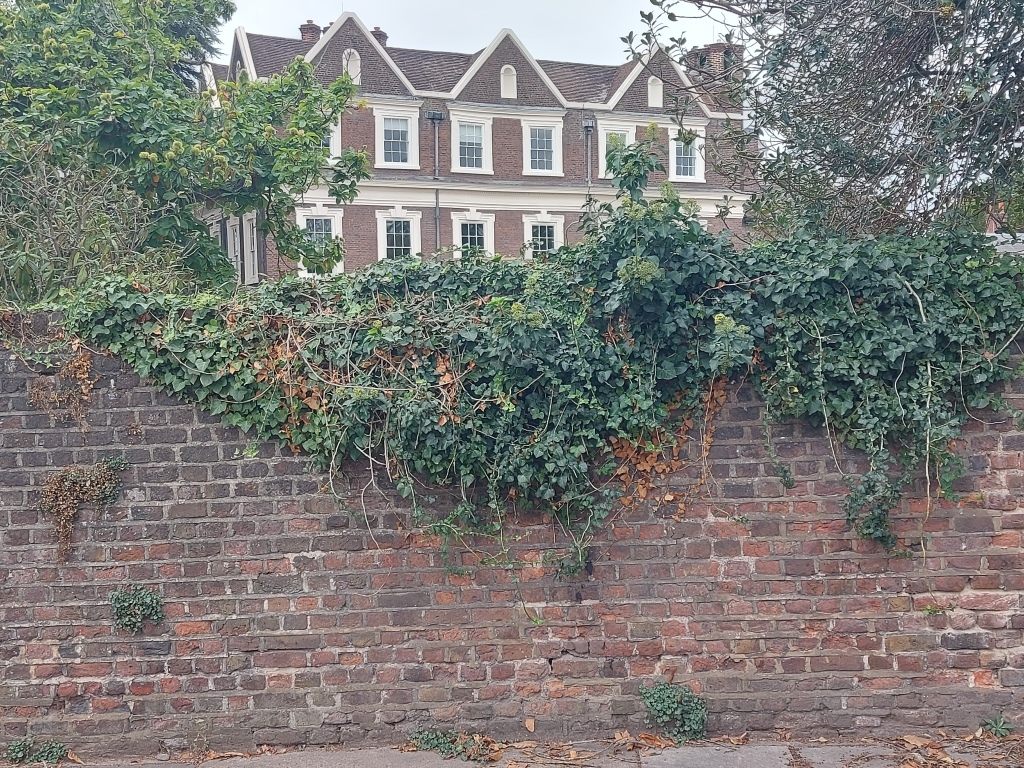
Peek-a-boo!
Meanwhile, the other side of Boston Manor Road was lined by a continuation of more Victorian-looking terraced housing. If you approach the bus stop for The Ride on the E8 or 195 bus, the automatic voice announces “The Ride” bus stop for you, in rich plummy tones, perhaps because it was once called Colonels Drive and is home to Gunnersbury Catholic School. Clitherow Road is a turning off The Ride, not to be confused with Clitherow Avenue not too far away up in Hanwell, both a nod I guess to the Clitherow family who owned the Boston Manor estate for 250 years until the 1920s. It’s also where we turn off on our way to Brentford home games, intoning “The Ride” as we do so.
From here to Manor Vale bus stop the residential facades opened out from terraced to a more semi-detached aspect.

The top of Manor Vale.
At the top of Manor Vale, I turned into a gentle dip of a side road and an intriguing step back in time. Mature trees and hedges of laurel, holly and privet preserve the privacy and dignity of these once swish three-storey art deco blocks. Now mild mannered tatty, untouched yet maintained, they were probably once home to the yuppies of 100 years ago. I wonder who lives there now.
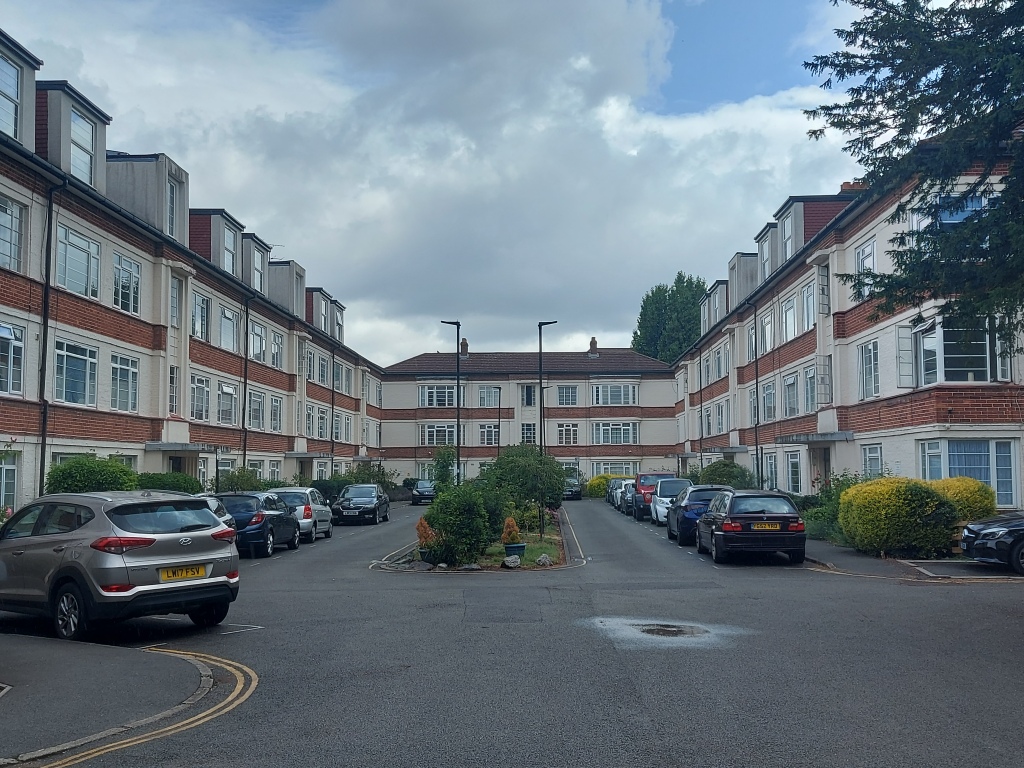
The bottom of Manor Vale.
At this point I felt myself being drawn nearer to the Great West Road and the cars flying across the elevated section of motorway that bisects the University of West London skyscraper and the distinctive mirrored glass and steel of the GSK edifice. Like an Asian city skyline in miniature.
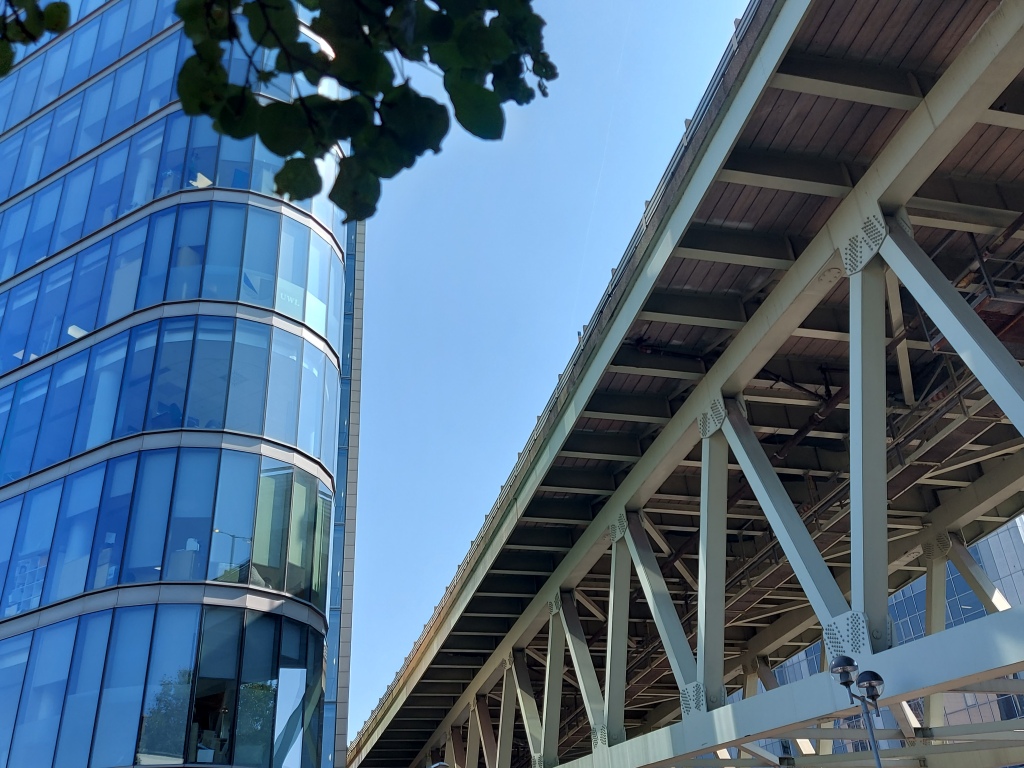
UWL tower and the flyover.

The flyover under construction.
But before that there were still many side road side shows to visit, that I’d been past on the bus, but never down. It gave a new perspective on the familiar.
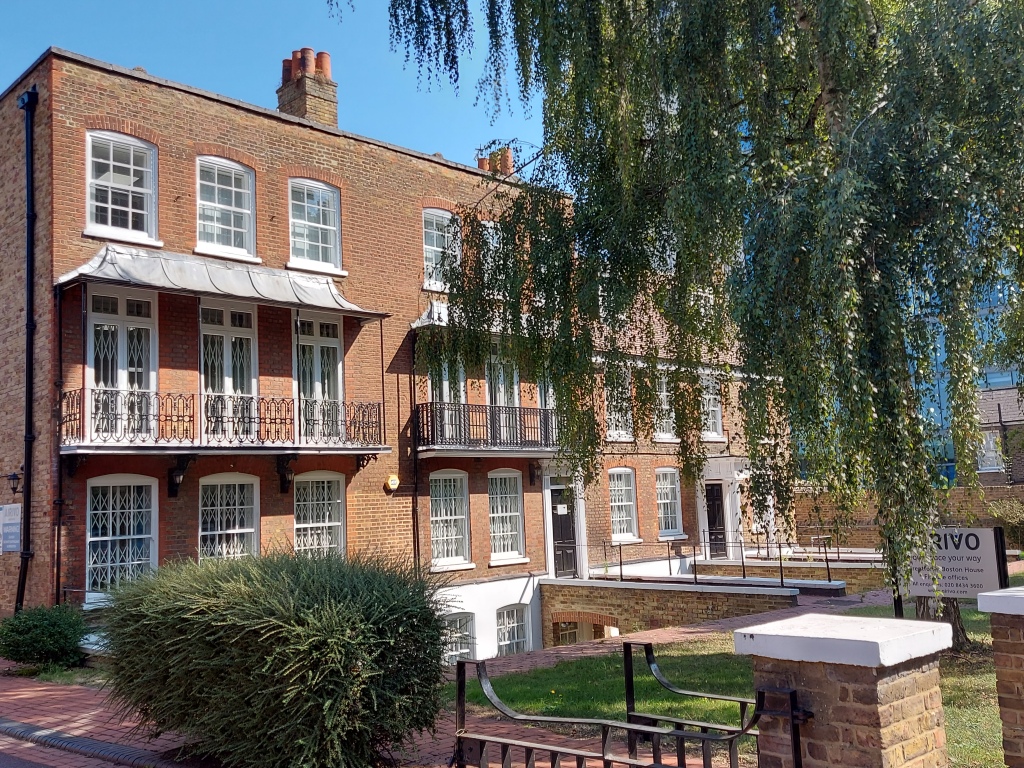
Boston House.
Georgian buildings cluster here, hiding low car parks: Clitherow Court, Boston House and Prospect House. Some are flats, others are neat office conversions.
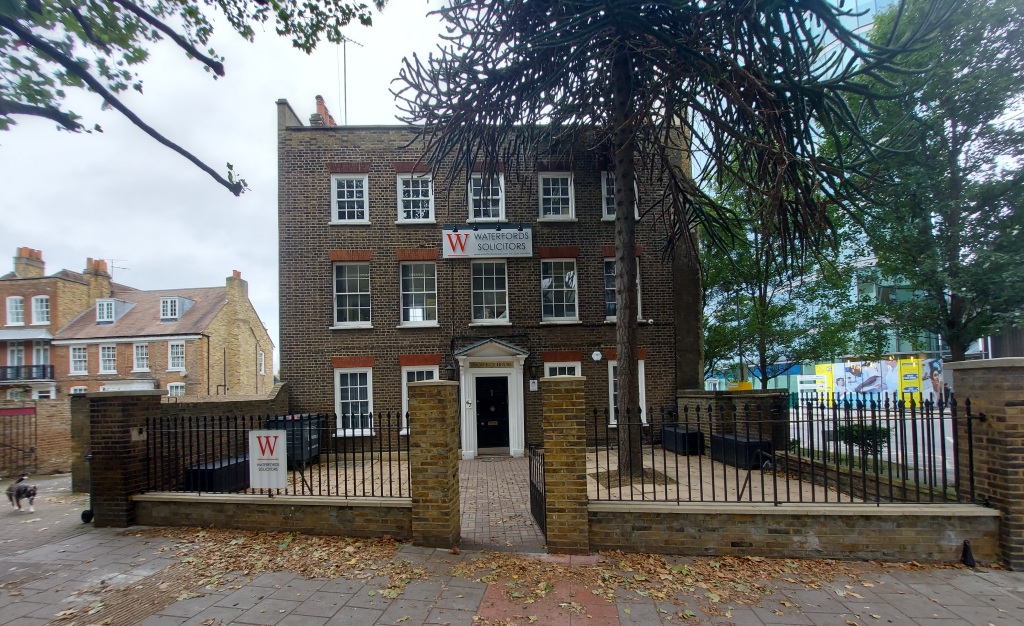
Prospect House.
Meanwhile, on the other side of the road, was a row of 60s/70s square houses; terraced boxes recessed into the long wall where it ends at the bottom section of Boston Manor Park. They were in varying degrees of repair but interestingly each one was different.
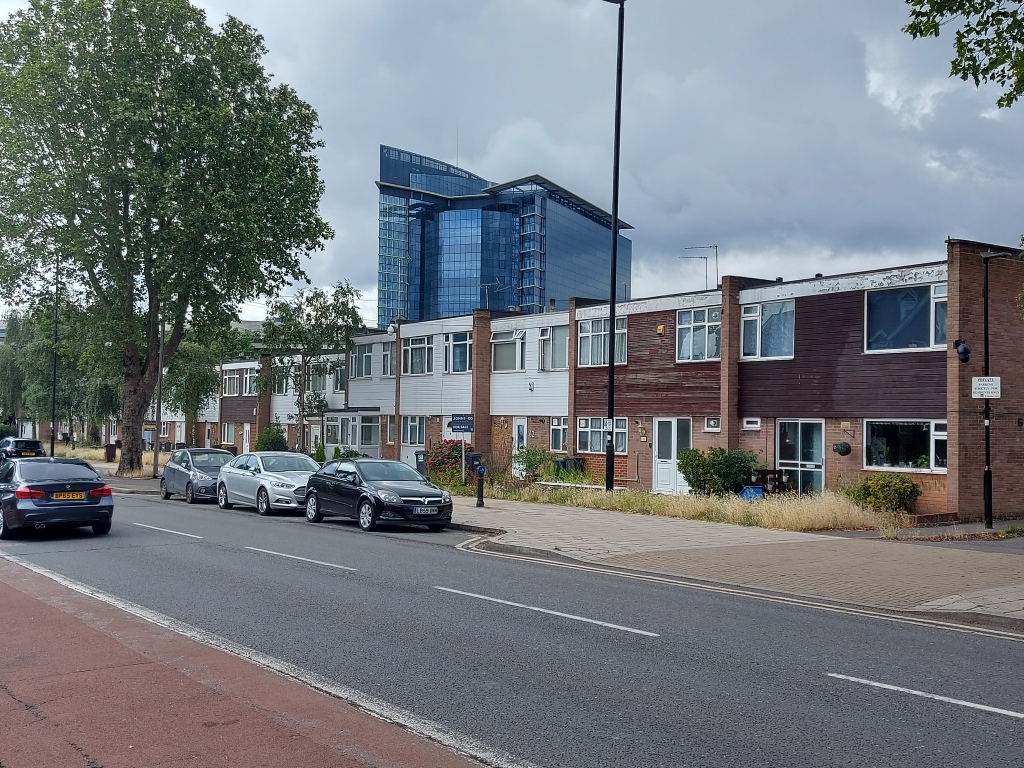
Box houses with GSK building behind.
As you drift under the flyover you can feel the pull of the new. The sea-green steel girders carrying the elevated section of the M4. The wedge of the Co-op shop next door to the UWL tower and The Mille office rental in the concrete tangle gloom. On the right is the tall glass and bright steel of the GSK building above the trees.
Boston Manor Road also continues on the other side of the Great West Road.
My passegiata complete, I turned around and squinted back up Boston Manor Road, thinking again of how it all looked 120 years ago. Indeed, aside from the manor house and its estate, from where I stood all the way up to the tube station was once a couple of farms, some fields and woods, and a muddy lane.
Houses started lining the Boston Road (as it was then called, and Boston Lane before that) from the mid-19th century after the arrival of the Great Western Railway. Trams rattled up and down the road. Another railway, the Midland District Railway followed the northern edge of the manor’s grounds and in 1880 Boston Road station was built, opening up the southern part of Hanwell to development. The station was renamed Boston Manor in 1911.
*With acknowledgements to Hanwell & Southall Through Time by Paul Howard Lang
If you’d like to find out more about Hanwell, local historian David Blackwell has a fascinating collection of books, maps and photos, old and new, of Hanwell and neighbouring areas. They are on display at Hanwell Library on the first Saturday of each month from 10am to 3pm. On the third Saturday of each month the display is more about Ealing in general.











































You must be logged in to post a comment.